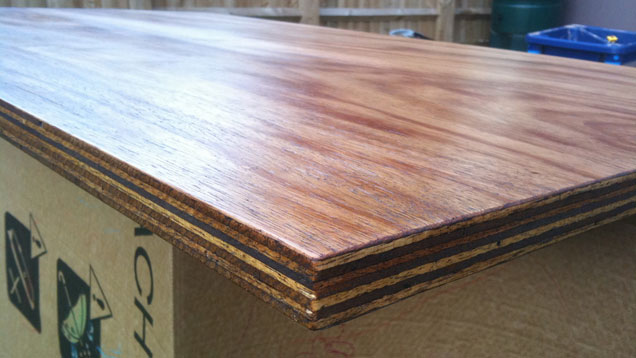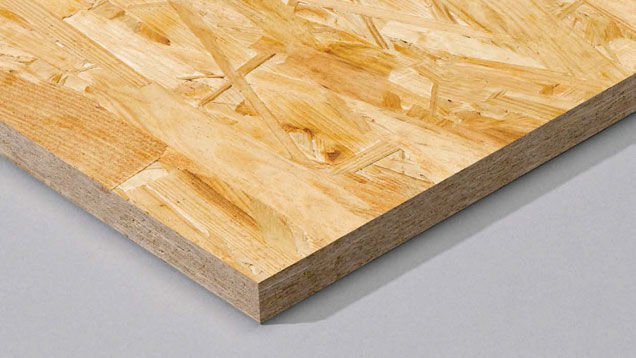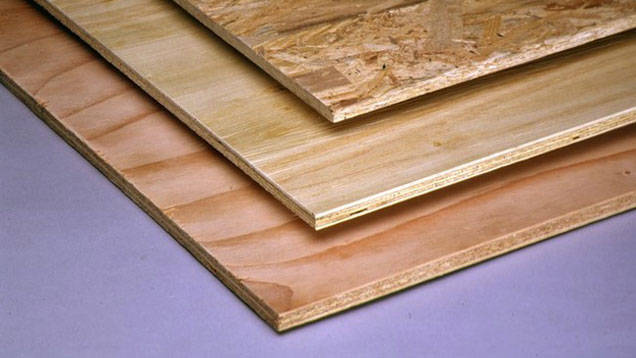Plywood used to be king for wall sheathing and flooring material, but oriented strand board (OSB), introduced in the late 70s, is now the most popular. But both have their advantages and disadvantages — so which should you use for your project?
Photos from Bob Vila, Oxley Woods, ArchiExpo
Both products can be used interchangeably by builders as roofing material, exterior wall sheathing, and floor underlayment. Each may be more common in certain areas and some builders have long-standing personal preferences to one or the other. DIYers will typically use plywood as it has a natural wood look.
Plywood Is Strong and Versatile, But Costly (Especially At Scale)

Plywood is manufactured from thin layers of wood veneer that are glued together with adjacent layers, having their wood grain rotated up to 90 degrees to one another.
Certain grades of plywood may be more susceptible to moisture, and less expensive veneers can have inconsistencies in the surface due to knots in the wood. Plywood is available in various thicknesses with ½” being the most popular for general construction.
Plywood is popular for construction for many reasons: it’s less likely to split when nailed or screwed at the edges due to its cross-grain construction, and it’s also lighter than solid wood, making it easier to manoeuvre and hang. It’s also less likely to swell, contract or warp due to the balanced tension across the grains of adjacent veneers. For all those advantages, though, it is more expensive than OSB.
OSB Saves You Money, But Loses On Aesthetics

OSB panels are an engineered wood particle board, made from wood that has been ground into thin wood strands. The strands are then mixed with wax and adhesives and hot-pressed to form wood sheets.
OSB has replaced plywood on most construction jobs due to its cost: it’s almost always less expensive than plywood, which is a major concern for contractors who are trying to win jobs based on price.
Contractors who use OSB like that it’s consistently stiff and dimensions are more accurate than plywood, which has greater variability. It can also be manufactured to sizes up to 8 feet x 24 feet (2.4m by 7.3m), which is much larger than most plywood panels.
Most plywood and OSB is sourced from young trees that grow quickly, so it is a more sustainable product than old growth timber.
So Which Should You Use?
Performance across both types of wood is very similar but if cost is your number one concern, OSB is the logical choice. But for applications where the wood will be exposed, such as making furniture or home improvement repairs, natural-looking plywood is superior.
You will also see MDF (medium density fibreboard) and particle board in the lumber section. These are closely related to OSB as they are also reconstituted wood product, but they are only suitable for interiors and most often used for furniture, cabinetry, moulding and shelves. Particle board can also be used as floor underlayment and as a substrate for countertops.
This article has been updated since its original publication

Comments
4 responses to “DIY Materials Showdown: Plywood Versus Oriented Strand Board (OSB)”
The price of plywood in Australia is nothing but a joke.
I totally agree. The quality is usually pretty poor too. I’m fed up of seeing various things on the internet being made from “cheap” high grade baltic birch plywood. I tend to carefully select individual BC grade sheets. AA grade is just silly money.
Not in this country. We use plaster board
No, plasterboard is used as wall lining. Plywood is used as wall “bracing”. The article calls it “sheathing”. Must be an American article. I think there is still very little OSB used in Australia, although it is starting to be used more and more.